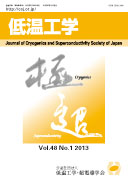All issues

Volume 48, Issue 8
Displaying 1-8 of 8 articles from this issue
- |<
- <
- 1
- >
- >|
Preface
-
Jun-ichi SHIMOYAMA2013Volume 48Issue 8 Pages 407
Published: August 25, 2013
Released on J-STAGE: September 11, 2013
JOURNAL FREE ACCESSDownload PDF (631K)
Feature: International Linear Collider (ILC)
-
Norihito OHUCHI2013Volume 48Issue 8 Pages 408
Published: August 25, 2013
Released on J-STAGE: September 11, 2013
JOURNAL FREE ACCESSDownload PDF (458K)
Review Articles
-
– Introduction –Akira YAMAMOTO2013Volume 48Issue 8 Pages 409-414
Published: August 25, 2013
Released on J-STAGE: September 11, 2013
JOURNAL FREE ACCESSThe international linear collider (ILC) is proposed as the next-energy-frontier particle accelerator anticipated to be realized through global cooperation. The ILC accelerator is composed of a pair of electron and positron linear accelerators to realize head-on collision with a center-of-mass energy of 500 (250+250) GeV. It is based on superconducting radio-frequency (SCRF) technology, and the R&D and technical design have progressed in the technical design phase since 2007, and the technical design report (TDR) reached completion in 2012. This report reviews the ILC general design and technology.View full abstractDownload PDF (2531K) -
Eiji KAKO2013Volume 48Issue 8 Pages 415-425
Published: August 25, 2013
Released on J-STAGE: September 11, 2013
JOURNAL FREE ACCESSAiming at construction of a future International Linear Collider (ILC), intensive R&D work to develop a superconducting (SC) cavity system consisting of a nine-cell cavity, a frequency tuner, an input coupler and two higher order mode couplers has been carried out at KEK. Approximately 30 nine-cell cavities were fabricated, and vertical tests to qualify high gradient performance were repeatedly carried out at the superconducting RF test facility (STF) in KEK. A maximum accelerating gradient higher than 35 MV/m, which is a target value for ILC, was achieved in approximately 90% of the latest 11 nine-cell cavities. Cryomodule tests with a high-power RF system at the STF were performed in three cryomodules including a total of 14 nine-cell cavities, and the stable pulsed operation at high gradients was successfully demonstrated. Remarkable progress in the technologies required for the SC cavity system in ILC has been made in the past several years.View full abstractDownload PDF (14660K) -
Hirotaka NAKAI2013Volume 48Issue 8 Pages 426-435
Published: August 25, 2013
Released on J-STAGE: September 11, 2013
JOURNAL FREE ACCESSThis article briefly introduces the International Linear Collider (ILC) cryomodules for superconducting RF cavities and the large-scale 2 K cryogenic system for the cryomodules. Fundamental ideas of continuous superfluid helium production are discussed using the example of the KEK-STF cryogenic system for superconducting RF cavity cryomodules, which provides a basic concept for large-scale superfluid helium cryogenic systems.View full abstractDownload PDF (2128K)
Original
-
Tensile Tests of Materials at Low Temperatures for ILC Superconducting RF Cavities and CryomodulesHirotaka NAKAI, Akio TERASHIMA, Eiichi YATABE2013Volume 48Issue 8 Pages 436-444
Published: August 25, 2013
Released on J-STAGE: September 11, 2013
JOURNAL FREE ACCESSSuperconducting RF cavities and their cryostats (cryomodules) for the International Linear Collider (ILC) are to be manufactured under the High Pressure Gas Safety Act in Japan to ensure the safe operation of the cavities and modules, if Japan takes part in their manufacture. Materials employed for the cavities and cryomodules and their welds should be evaluated in terms of their tensile strength both at room temperature and at the design temperature. Tensile tests of materials and welds for superconducting RF cavities and cryomodules have been carried out comprehensively in relation to the ILC project at KEK. Some results of the tests were submitted to the High Pressure Gas Safety Institute of Japan (KHK) for pre-evaluation of the materials to manufacture superconducting RF cavities and cryomodules.View full abstractDownload PDF (3160K)
Technical Note
-
Hirotaka NAKAI, Akio TERASHIMA2013Volume 48Issue 8 Pages 445-450
Published: August 25, 2013
Released on J-STAGE: September 11, 2013
JOURNAL FREE ACCESSSuperconducting RF cavities and their cryostats (cryomodules) for the International Linear Collider (ILC) are to be manufactured in Japan under the High Pressure Gas Safety Act to ensure the safe operation of the cavities and modules. Welds of employed materials for the cavities and cryomodules should be evaluated in terms of their absorbed energies both at room temperature and at the design temperature. Charpy impact tests of materials and welds for superconducting RF cavities and cryomodules have been carried out comprehensively in relation to the ILC project at KEK. Some results of the tests were submitted to the High Pressure Gas Safety Institute of Japan (KHK) for pre-evaluation of the materials and welds to manufacture superconducting RF cavities and cryomodules.View full abstractDownload PDF (1794K)
Cryogenic Group
-
Hitoshi HAYANO, Takaaki FURUYA, eiji kako, Yoshiyuki MORITA, Hirotaka ...2013Volume 48Issue 8 Pages 451-455
Published: August 25, 2013
Released on J-STAGE: September 11, 2013
JOURNAL FREE ACCESSDownload PDF (3293K)
- |<
- <
- 1
- >
- >|